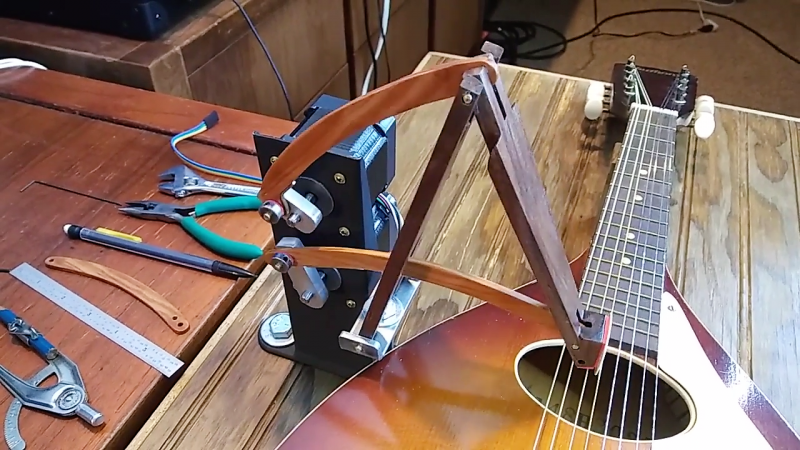Is there no occupation safe from the scourge of robotic replacement? First it was the automobile assemblers, then fast food workers, and now it’s the — mandolin players?
Probably not, unless [Clayton Darwin]’s mandolin playing pluck-bot has anything to say about it. The pick-wielding delta-ish robot can be seen in action in the video below, plucking out the iconic opening measures of that 70s prom-theme favorite, “Colour My World.” The robot consists of two stepper motors connected to a hinged wooden arm by two pushrods. We had to slow the video down to catch the motion, but it looks like [Clayton] has worked out the kinematics so that the pick can be positioned in front of any of the mandolin’s eight strings. A quick move of the lower stepper then flicks the pick across a string and plucks it. [Clayton] goes into some detail about how he built the motion-control part in an earlier video; he also proves that steppers are better musicians than we’ll ever be with a little “Axel F” break.
It’s only a beginning, of course, but the complexity of the kinematics just goes to show how simple playing an instrument isn’t. Unless, of course, you unleash an endless waterfall of marbles on the problem.
Thanks for the tip, [baldpower].
















cool
Arc Delta. The kinematics are far more complex than a linear delta.
What is Arc Delta? This is 2D and the curved parts can be straight and it works the same doesn’t it? Or is it because of the extra lever? It seems that is similar, but less complicated than the platform at the end of a delta?
I believe the arc part refers to how the motors rotate an additional linkage in an arc rather than a linear actuator like you usually see on delta printers–where belts or screws move three carriages vertically, to which are attached the arm linkages.
Linear Cartesian Series Kinematics: (Prusa configuration) This is your standard 3D printer. The Stepper motors movement is converted to a linear motion by a belt. Motions are in series and only the last of the series is connected to the end effector. The kinematics are simple. xSteps = x * xConstant; ySteps = y * yConstant; etc
Linear Delta Parallel Kinematics: (Kossel configuration) Once again belts are used to convert the rotation of the steppers to a linear movement. All 3 steppers move the end effector in parallel rather than series. The kinematics is more complex, lots of cos() and sin() and the equations are no longer independent as any one stepper effects x, y and z
Arc Delta Parallel Kinematics: The motion of the steppers remains rotational (arc). The kinematics is even more complex. Often used in industry for it’s speed.
https://cdn.hackaday.io/images/995561461550437229.JPG
More complex, sure, but it’s just math. When you’ve solved the equations, it doesn’t add any complexity.
It sounds like the robot is humming along to its own music
+1
Another real life Animusic! Nicely done.
It’s a mandocello and not a mandolin.
I think it’s a mandolin but tuned in such a way that the robot has more notes to play. You’ll notice there are no fingers on the fretboard.
That seems like a bit of a limitation. I suppose the plan probably includes adding a separate robot for that. Er. Four more robots.
Definitely a Harmony MANDOLIN made in Chicago in the 1960’s. They didn’t make mandocello’s.
Looks like the string spacing has been modified at the bridge.
Impressive.For an even more pleasing result, a bit of variation in the timing (aka swing) would probably work really well.
since there isn’t any device for the frets, its kind of limited to the basic notes of the string, But I bet this would be an absolute AWESOME harp player!
That damn song is stuck in my head now.
Looks pretty nice, cool idea to use wood for the mechanism.
Hoping to see this soon…
https://youtu.be/toXNVbvFXyk
Yeeeesss! I forgot all about this! Thanks for reminding me!
nice.
my favourite is still this:
https://www.youtube.com/watch?v=5UYMnzXQEtw
It’s really hard to play. With the help of only two woods